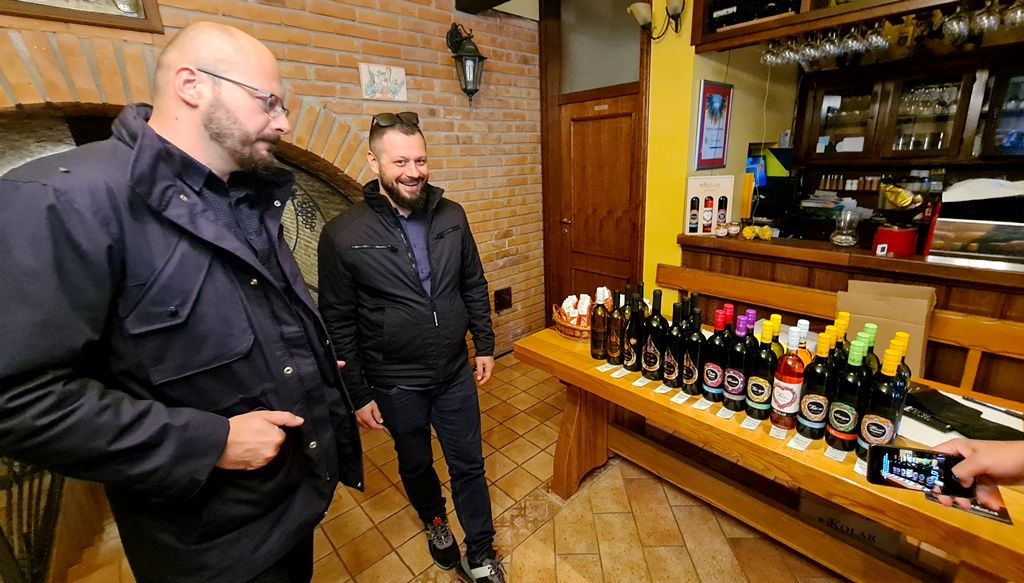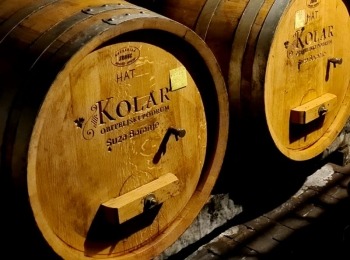Experiencing and tasting Podunavlje: from Podolian “perkelt” and brilliant wines to sweet “taške” pastries
The opulent eastern Croatia, extending along the mighty Danube, has substantial agrotourism and wine tourism potential. On our “Green Visit Podunavlje” trip, we sampled the most popular local dishes and drinks of Baranja and Srijem.
If only the fog would lift, if only the fog would lift, we were thinking to ourselves as the nine of us we were making our way to Kopački rit in the van that had picked us up in Osijek earlier that morning, with our fellow travellers from Zagreb already on board. Our mission: to see, experience and taste Podunavlje.
As we waited for the sun to break through the clouds, we made a stop at the Kopački rit Reception Centre, watched a short film about the nature park, unique in Baranja, Croatia, and Europe by how well-preserved its flora and fauna is, learned about all the ways to reach the park, and the plans and ambitions for the place, took a ride on electric bicycles... and still the fog refused to release its hold on the swamp.

Deer and boar mating season
It did not stop us from taking a ride in electric boats through the Čonakut channel and to the Kopačko jezero lake, under the vigilant gazes of the cormorants sitting in naked, dry boughs. The whole scene would have seemed eerie had there not been for our boat operator Oliver Krištof, a tourist boat captain by vocation, who regaled us with stories about all the different fish of the Rit (and the sausages he makes from them), the differences between otter’s and beaver’s dens, and the reason why the boughs that the cormorants were sitting on had dried up (which happens to be because of their droppings, in case you were wondering). We also learned if there really are any mines in the places marked with “Caution: Mines” signs, where the Croatian forces were positioned in the War of Independence, and when the deer and the boar mating season is.
As we listened to his stories and watched the quiet, humid swamp, we forgot all about the coldness and dampness of the late October afternoon.
As we thanked Oliver and said our goodbyes at the end of our ride, he promised to bring us something to drink the next time to keep us warm. He had no idea we would be open to it. He thought we were English or something.

Slavonian Syrmian Podolian “perkelt”
We were warmed up soon enough by “rakija” (brandy) made from quinces at the Citadela Restaurant in Vardarac, a famous Baranja cuisine spot, some six kilometres away. At lunchtime on Friday, the restaurant was packed with businesspeople, families and groups of friends who decided to get a head start on their weekend, with some good food and even better wine.
We needed no brandy to stimulate our appetite – the cold air of the swamp had done a perfect job already – but it still prepared our stomachs nicely for the traditional catfish “perkelt” (stew), served with homemade noodles topped with fried bacon and cottage cheese, and followed up with a brand-new dish on the restaurant’s menu, “perkelt” made from Slavonian Syrmian Podolian beef, bred locally, right there at the restaurant’s own back yard. The Lazar family, who own the Citadela restaurant and farm, grow their own crops and breed their own cattle, including this autochthonous breed. The Podolian “perkelt” is their house special.
The “fiš” (fish stew), served with noodles, excellent as always, and the amazing melt-in-your mouth “perkelt”, were paired perfectly with Gerstmajer’s Graševina white wine – or so my colleagues informed me. Being a vegan, the author of this text paired Graševina with some grilled vegetables and “šopska” salad (typically made of tomatoes, cucumbers and peppers), minus the cheese. The fault is all mine for not informing the right person about my lifestyle choices on time.

No time to rest: a walk down a “surduk” street to visit “gator” wine cellars
Our stomachs full, it was time to head to Zmajevac and take a walk down its sunlit “surduk”, a picturesque, narrow, cobbled street lined with the wine cellars typical of the region, known as “gator” in the local dialect (and say hello to the kitties we saw dashing between the cellars). It was also time for some wine tasting at the famous local Josić Winery, also decorated in a picturesque style, and for the presentation of the new Josić Art Edition wine label, developed in cooperation with Stanko Abadžić, one of the most esteemed Croatian art photographers, who has staged independent exhibitions in more than 16 European countries, as well as in Argentina, Japan and the USA. Interestingly, this is the first Croatian wine label in history to bear the print of a female nude.
Unfiltered art edition
We sampled Graševina, Chardonnay and 2021 Josić Cuvée, which our wine connoisseurs agreed still needs to “grow up”. “This is oeno-paedophilia!”, Denis Despot of Association Dekanter joked, and Nenad Trifunović Vinopija, wine connoisseur and author of the “Dnevnik vinopije” (Oenophile Diaries) blog, smilingly agreed. The two of them made up our small, but strong team that decided to explore the oenological and gastronomical delights of Podunavlje on this last weekend in October, together with our tourist guide Mislav Pavošević, Agroglas journalist Vesna Latinović, tourist guide and heritage interpreter Dubravko Fijačko, travel agency owner Stella Ema Ćupen, Kristina Babić of the Croatian Association for Tourism and Rural Development “Village Membership Club”, who organised the “Green Visit Podunavlje” trip, and yours truly.
The Josić Winery told us that they were expecting a good year. The rains in September caused no damage to the grapes, because they had already been formed. They also told us that their number of visitors has tripled. In particular, they have had lots of Polish tourists, who visit the region before or after taking a trip to the Adriatic, and they have also had tourists from the USA, New Zealand, Australia and Japan.

As befits a Friday, we took no time to rest. Taking our leave from the Josić Winery, our next stop was winemaker Ljudevit Lajoš Kolar in Suza, some three kilometres away. His family farm, which combines winemaking with tourism, is called “Suza Baranje” (a pun in Croatian: “Suza” is the name of the village, but “suza” also means “tear”). As we enjoyed tasting his wines, Lajoš proudly told us that his family plants as many as 12 grape varieties in his vineyards, spanning approximately 12 hectares, and produces as many as 20 wine labels. This year, two of them, Chardonnay and Pinot Gris, both 2018 vintages, won the Bronze and Silver medals in Decanter World Wine Awards, the world’s largest and most influential wine competition.
Ljudevit Lajoš Kolar
The family expects excellent grape quality this year. The yield has been reduced by the rain, but there was also less moisture. They started harvesting their grapes as early as on 18 August, and there were still grapes of the graševina variety left to harvest on 27 October for serious Prädikat wines. “The parameters are good, but we must make no assumptions”, Kolar told us, adding that they are waiting for the En Primeur in Zagreb, when the new wines from last year’s harvest will be presented, along with older vintage wines that are yet to hit the market.
In addition to their wines and restaurant, offering a variety of dishes, the Kolar family farm includes a campsite that receives a number of tourists every year.

Master Daniel’s skilful hands
The Asztalos Pottery Workshop is located in a former mill, almost across the street from the Kolar cellars. Its owner, Daniel Asztalos, makes pottery using traditional Hungarian artisans’ techniques. He was only too happy to spin the pottery wheel and give us a first-hand demonstration of the process of making a pottery plate, pot or bowl. Daniel makes ceramic dishes that are used in the preparation of traditional local specialties, such as bean pots and “sekeli” (sauerkraut and pork) stew pots, but also milk jars, cups, souvenirs and jewellery. He told us about an increasing interest in pottery, and visits of tourists from all over the world.

A bike ride through the fog
By the time we left his workshop, captivated by the experience, it was already dark outside. We then made our way to Vukovar and the Lola Hotel, located in the Paunović Family Palace, built in the 19th century, sitting smack-dab in the middle of the Baroque-style city centre, a protected cultural landscape. The Domestic House restaurant served us a sensational menu for dinner, consisting of spring rolls, game and wild mushrooms risotto, pork ribs, braised pork jowls, game “brasato” in a dark red wine sauce, served with “Schupfnudeln” (potato dumplings), beefsteak, black pig neck confit, and an excellent veggie stir fry. You will forgive me if I forgot something. We washed all this down with superb Graševina from Ilok, Trs Winery’s Coupage, and, finally, in the small hours, with Kapistran red wine by Iločki podrumi.
















